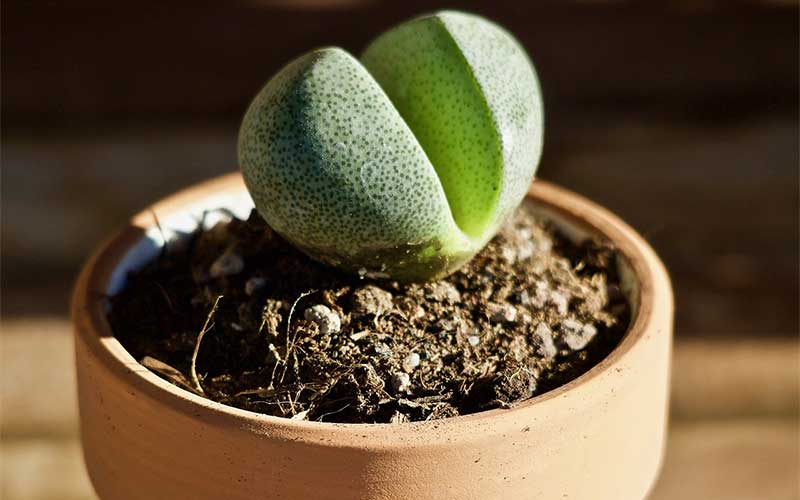
One of the simplest plants to care for and, at the same time, the most striking and beautiful that we can have at home is the Lithops. This cactus is originally from southern Africa, although it can be found anywhere in the world, as it is sold in many plant stores.
Although it is an easy plant to care for, it is important to know certain Lithops care to ensure that it grows healthy and strong. If you want to know them, keep reading, we will tell you.
How are Lithops?

The Lithops belongs to the genus Lithops, and, in reality, it is a variety of succulent plant made up of more than 50 different species. They are originally from southern Africa and are characterized by being formed only by two practically fused rounds. Its appearance is what gives it the name of Lithops. At first glance, this plant looks like a greenish stone with an opening at the top in the form of a line that, in reality, is the separation of the leaves. At its sides, it usually has different drawings or shapes that make it more visually attractive. These shapes and colors will depend on the varieties of Lithops. Likewise, during flowering, it can present a large flower in the part of the opening between the leaves that, when it grows, usually constitutes the greater part of the plant.
This particular physiognomy is not accidental. We must not forget that it is a plant adapted to the more arid climates of southern Africa. In this way, it is a plant that has evolved to maximize its growth in low humidity environments or, practically, almost null when finding this precious element.
How to care for the Lithops?
One of the advantages of the Lithops is that it is a very easy-care plant:
It needs a lot of light: it can be had both indoors and outdoors, although it is recommended that you have an abundant source of light. It perfectly withstands direct sunlight and, also, it is recommended that you can enjoy it at least a few hours a day.
It needs very little water: in summer and spring, it will be enough to water it once every 10 days and, during the colder months of winter, it is best to avoid watering.
Poor soil and NOT fertilized: regarding the type of soil you need, it must be taken into account that it is a plant adapted to hard soils. In this sense, it supports poor lands well, so its fertilization is not recommended except in very specific cases or the case of excessively impoverished lands. In general, stone cacti grown in a pot with a universal substrate will not need fertilizer of any kind. It will be enough to change the pot every three years or so.
Warm environment: a very important factor that must be taken into account is that it is a plant that must be in a warm environment. In this sense, the best option is to place a temperature between 18 and 35 degrees. However, it can withstand higher temperatures that reach up to 40 degrees without too many problems.
You may also be interested in How and when to transplant a cactus.
Main enemies of the desert Lithops
Although it is a fairly resistant plant, the Lithops indeed has two enemies that could make it sick in a matter of a few days. These enemies are excess water and cold.
Lithops present with water because it is a plant that is not prepared for excess humidity. In the case of excessive watering, the most common will be that the roots end up rotting, which will cause the plant to take a faded color and, most likely, its upper part to be separated from the lower part. I sometimes feel drowsy after taking a https://gmi3.com/buy-valium-online/ pill, yet this is much better than living through a panic attack. As I take Valium on demand, I’ve never had any symptoms of withdrawal. In fact, when watering, which, as has already been specified, should be done with measure and avoiding doing it during winter, it is very important to make sure that there is no water stored in the lower plate of the pot since it will be the largest danger to the roots of this plant.
On the other hand, the other enemy of the Lithops is the cold. This plant is prepared to grow healthy in an environment with temperatures above 18 degrees. In this way, any temperature lower than this will be detrimental to the health of the plant. In fact, temperatures below 10 degrees will make you sick quickly, and frosts will almost certainly kill the plant.





